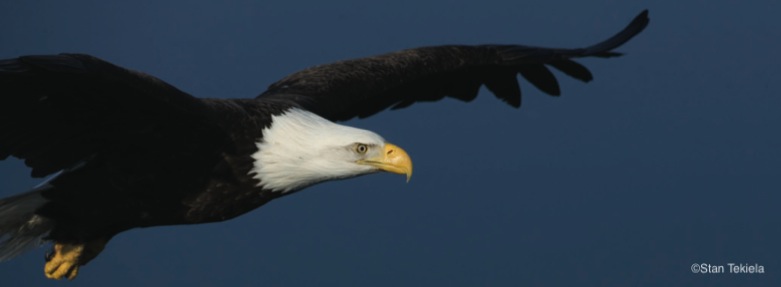
The Majesty of Our Eagles
Stan Tekiela, author of Majestic Eagles, shares with us his knowledge and amazing pictures of our national symbol.
There are nearly 60 eagle species in the world. Found on every continent except Antarctica, the overwhelming majority occur in the Old World, three species are seen in Australia, and a few are in South America. Ornithologists have divided all eagle species into four groups based on similar traits—the Sea and Fish Eagle, Booted Eagle, Snake Eagle, and Harpy Eagle groups, with the Bald Eagle fitting rightly into the Sea and Fish Eagle group (due to its close association with water and fishing).
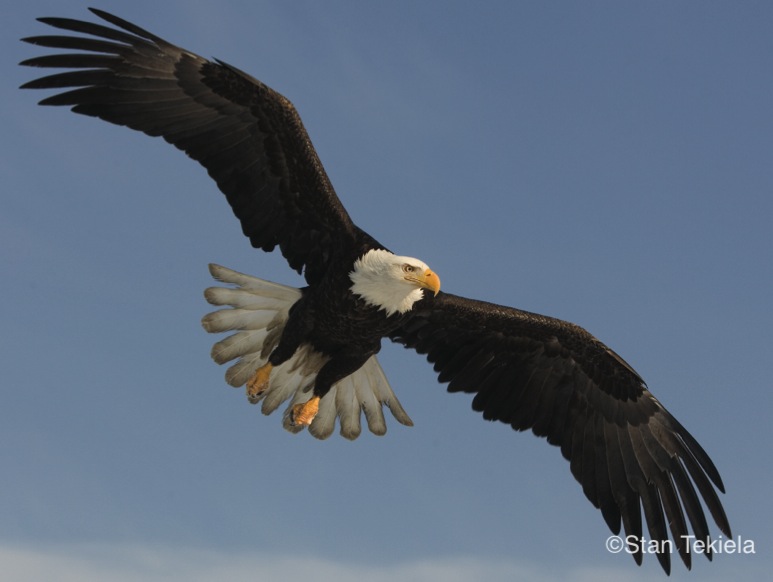
The Bald Eagle and Golden Eagle are the only two species in North America. The Golden is seen around the world in northern temperate regions. The Bald Eagle occurs only in North America, namely the United States, Canada, and Mexico. While we don’t have a large variety of eagle species in North America, in the Bald Eagle we have a unique eagle and one of the most handsome.
Through history, the Bald Eagle has also been called the Fish Eagle, Black-and-Brown Eagle, White-tailed Eagle, Washington Eagle, Washington Sea Eagle, American Eagle, American Bald Eagle, and Bald-headed Eagle. It is now officially called the Bald Eagle.
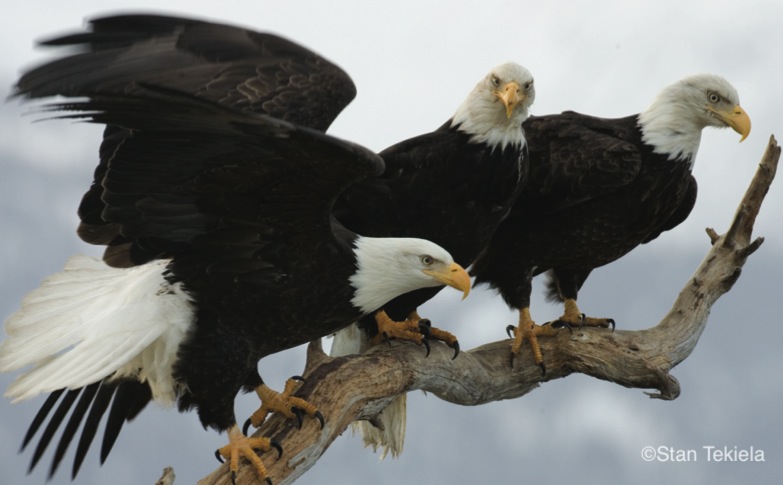
Obviously, the Bald Eagle is not bald, but the white head and neck of the adult bird give it a bald appearance. Appearing bald, however, is not the reason for the first part of the common name. Back in Middle English times, the word ballede was synonymous with “white” or “shining white,” not hairless. Either way, “Bald” in the name seems to be appropriate.
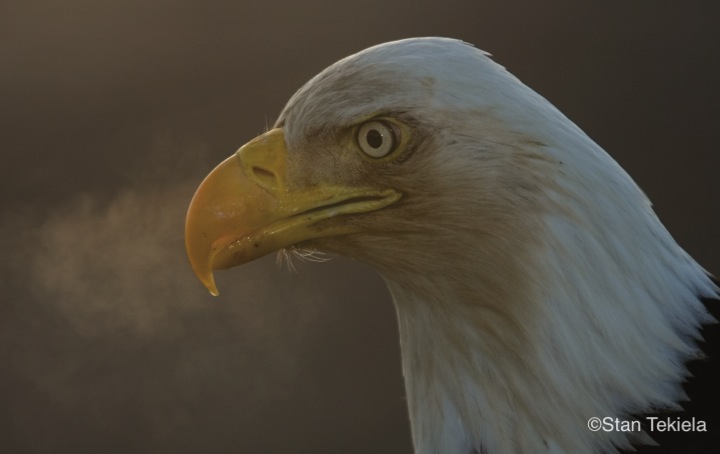
“Eagle” came from the Latin aquilus, which means “dark” or perhaps “the north wind,” which brought dark storms—so, altogether, it meant “the black eagle.”
The Bald Eagle is truly an American bird. In the right habitat, it can be found all over the United States. Its range is across most of Alaska, through Canada to the tip of Florida, Texas, California, and into Mexico. Bald Eagles in the southern part of the range tend to be 10 percent smaller than their northern counterparts, with shorter wings and 20 percent shorter tails. At one time in the past, these differences constituted a subspecies. Because populations of northern and southern birds were found to be intertwining, they were classified into one species—although juvenile Bald Eagles (as shown) are still sometimes mistaken for Golden Eagles.
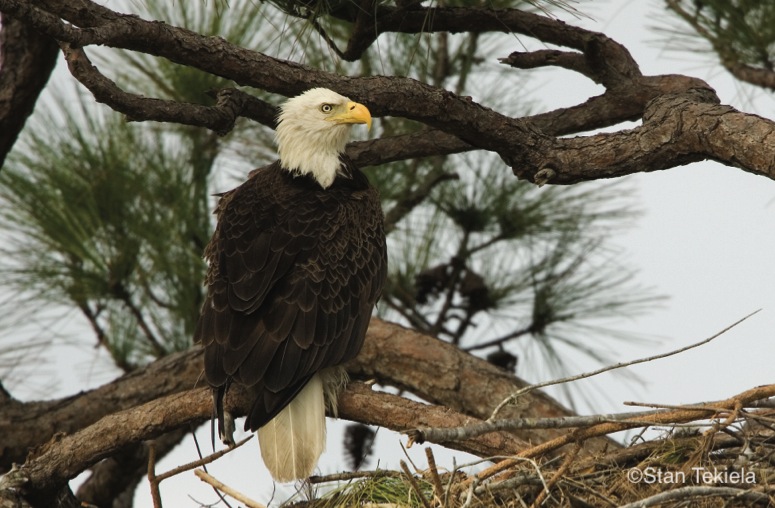
Bald Eagles are not closely related to our other native eagle, the Golden Eagle. Goldens are usually far from water, often in mountainous regions, feeding mainly on rabbits, hares, and other small- to medium-size mammals. The Bald Eagle is usually associated with water, making its living by fishing and chasing waterfowl, such as this Mallard. However, increasing populations of Bald Eagles have forced many eagles away from water, to eke out a living on road-killed animals, such as deer, squirrels, and rabbits, in less prime habitats.
The Bald Eagle presumably had stable, if not growing populations before European settlement. It is estimated that there may have been 500,000 Bald Eagles in the continental United States at that time. Back then, American Indians would have killed some eagles for feathers, but this activity obviously would not have impacted the overall population. One thing is sure—most American Indians revered the Bald Eagle and honored the ideals it represented, so it wouldn’t be far-fetched to say that the decline of Bald Eagle populations didn’t start until after European settlement. In fact, settlers who considered the bird competition for precious food oftentimes shot eagles. Other pioneers shot eagles, believing them to be killers just from bloodthirstiness. Of course, this notion was unequivocally not true. Bald Eagles, such as these adults and juvenile, kill only to eat.
It is estimated that when the Bald Eagle was adopted as our national symbol in 1782, there were only about 100,000 nesting pairs and reports had already been made of its decline. Many factors have taken a toll on the populations of this magnificent bird of prey—indiscriminate shooting, prejudice, poison baits for killing coyotes and wolves, government bounties, systematic use of the pesticide DDT and dumping of other toxic chemicals, habitat destruction, overfishing (which reduced a significant food source), and lack of education about the eagle’s role in the environment.
Populations steadily declined until the 1940s, when the first attempts to help the plight of the eagle were made. The Bald Eagle Act, passed in 1940, provided some protection and gave a glimmer of hope that the eagle would make a return. This bright spot quickly dimmed, however, when it was discovered the effects of DDT were having on Bald Eagles, Common Loons, and many other large predatory birds. DDT had been heralded as a miracle chemical for its effective control of insects. What was not understood at the time was the building up of DDT (bioaccumulation), which was how the pesticide occurred in top predators such as eagles.
DDT was sprayed liberally to control insects. The insects were contaminated and then eaten by fish. A fish might eat hundreds of insects, all of which had trace amounts of the pesticide. As the fish ate more contaminated insects, the amount of DDT increased in its own body. Now enter the Bald Eagle. A large portion of its diet is fish, and most fish had small amounts of pesticides. With each fish it ate, an eagle consumed more and more contaminant, resulting in a large dose of DDT delivered into the eagle’s system (DDT bioaccumulation).
The pesticide didn’t produce external symptoms in adult birds, but it greatly impacted the reproductive system. DDT bioaccumulation caused Bald Eagle eggshells to become thin and fragile—so much so that the weight of incubating adults was causing the shells to break, killing the developing chicks. Because eagles can live 20 years or more in the wild, the effects of diminished reproduction went unnoticed until after the contaminated adult birds started dying of natural causes. The lack of a younger generation of eagles to replace the aged and dying eagles pointed to the painfully obvious effects of DDT. By then it was nearly too late to save the species. Eagles had been eliminated from many regions and were barely holding on in others.
By the early 1960s, the population of eagles hit its all-time low due to DDT bioaccumulation, with an estimated population of just over 400 nesting pairs in the lower 48 states. At this time, Alaska and Canada had relatively robust populations, but these were also impacted and declining. In addition, fishermen who thought they were protecting salmon, resulting in a reduction of at least 100,000 more eagles over the past century, were killing Bald Eagles in Alaska.
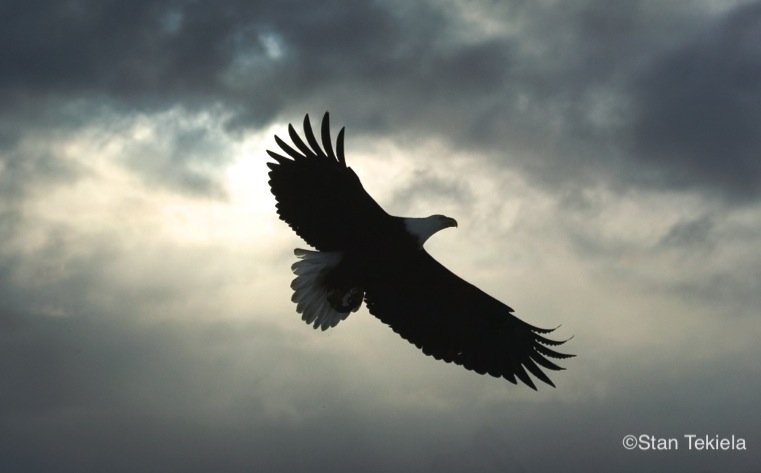
The 1970s were the turning point in the recovery of the Bald Eagle. Two significant issues came to fruition during this decade. The first was the banning of DDT in the United States in 1972. It would take many years for the effects of the pesticide to flush through the natural cycles, but we were well on the road to recovery. The second and, some say, just as important, was the passing of the Endangered Species Act in 1973. This landmark legislation protected the Bald Eagle and many other species in peril. It provided special protection with consequences for violators of the law.
In addition to these two major events, something less tangible had been occurring. The 1960–70s birthed a widespread environmental movement that, to a certain extent, continues today. A key component of the movement was environmental education. Providing accurate information about every part of our environment, habitats, and their vital interrelationships became the staple for schools and nature centers across the country. The children of our nation started to learn for the first time about the value of a thriving environment, the importance of keeping every species from tiny insects to large furry animals healthy, and how crucial the habitat is to all species, including humans. Most importantly, our children began to learn that the natural world is interconnected in a large web of life, that if one part of the environment is changed, the effects will be felt across the entire ecosystem.
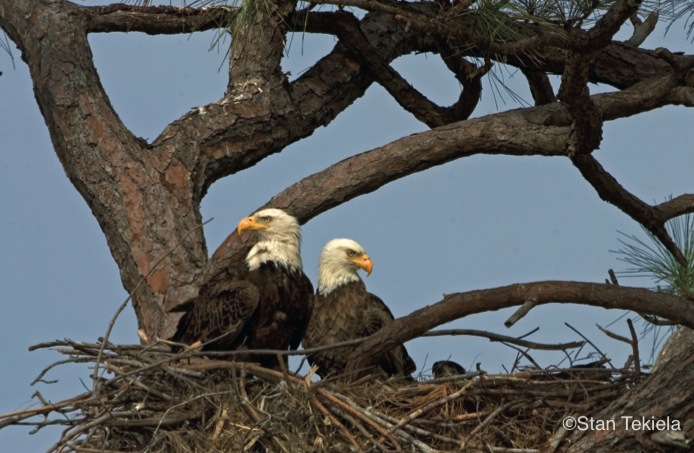
Federal and state agencies were more focused at that time on providing hunting and fishing opportunities, but they started devoting additional effort and money to nongame species. Over the following decades this trend continued. A healthy environment for nongame species also means a healthy one for game species. Today, we regard the Bald Eagle and other nongame species as an essential component of a healthy, well- balanced, and flourishing environment.
For more stories about wildlife and nature, sign up for our newsletter now!


